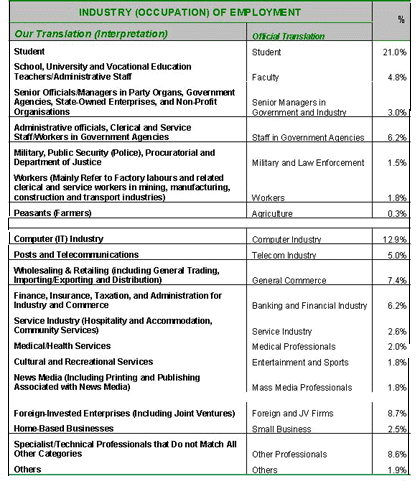 |
Analysis Internet Development in China: An Analysis of the CNNIC Survey Report Peter Weigang Lu IV. THE INDUSTRY AND OCCUPATION OF CHINA'S INTERNET USERS There are no national standards for classification of a person's industry and occupation in China. The CNNIC survey tried to elicit information both about its respondents' industry and occupation in the same multiple choice question. In doing so the question violated the principle that multiple-choice questions must address only one subject at a time. The survey question was weighted toward industry and when the survey designer attempted to ask about occupation in the same question, confusion resulted. The following table is a tentative effort to clarify the misleading and confusing part of the CNNIC survey results about the industry and occupation of China's Internet users. We see that incorrect translations from the original Chinese version add more confusing and misleading problems for Westerners reading the report.
 NOTES:
1. A majority of corporate directors and/or executives at large and medium-sized state-owned enterprises (SOEs) in various industries selected the category of Senior Officials/Managers in Party Organs, Government Agencies, SOEs and Non-Profit Organizations rather than their relevant industry categories. The answer alternatives provided for the question regarding industry and occupation have been different in each of CNNIC's five surveys. Only five or six categories between the surveys are comparable, assuming that changes in industry definitions and the availability of other categories to choose have had no substantial effect on respondents' selections. Among those which have remained relatively consistent are the three categories of Student, Computer (IT) Industry, and Posts and Telecommunications. While the percentage of students has risen to 21 percent from 13.6 percent in October 1997, that of computer industry employee has dropped to 12.9 percent from a peak of 18.8 percent in July 1998, and that of post and telecom industry employee dropped to 5 percent from 8.7 percent in January 1999. The growth rates of Internet users in Cultural and Recreational Services, Hospitality and Accommodation Services, Medical/Health Services, Wholesaling and Retailing, Financial Services, and Home-Based Businesses were all greater than the total user growth rate. This indicates that China's Internet is moving out of its early adoption stage and gaining popularity among the masses. The percentage of students among the total users is arguable, as one of the inherent faults of online survey methods is that the samples are not randomized. It is reasonably believed that prizes advertised to draw respondents in most online surveys are more appealing to students than any other group of people. Students as a group can also be more effectively reached. There were reports that when the CNNIC survey went online at the end of 1999, quite a few Chinese ISPs/ICPs went to university campuses to bribe students for votes in the hope that their Web sites might be ranked on top when the CNNIC survey report came out. Peter Weigang Lu, 37, holds and MBA from the Australian Graduate School of Management at the University of New South Wales. Although his ten years work experience in China is IT-irrelevant, he has embraced the Internet era wholeheartedly. Tomorrow: Parts V, VI, and VII. |
 This Article Previous Articles
|
||||||||||||||
|
Infotech: News | Analysis | Reviews | Perspectives | Events | Resources Home | Search | News | Trade | Finance | Infotech | Leisure | Shop |
|||||||||||||||
| ©1999 - 2000 Virtual China, Inc. All rights reserved. | |||||||||||||||